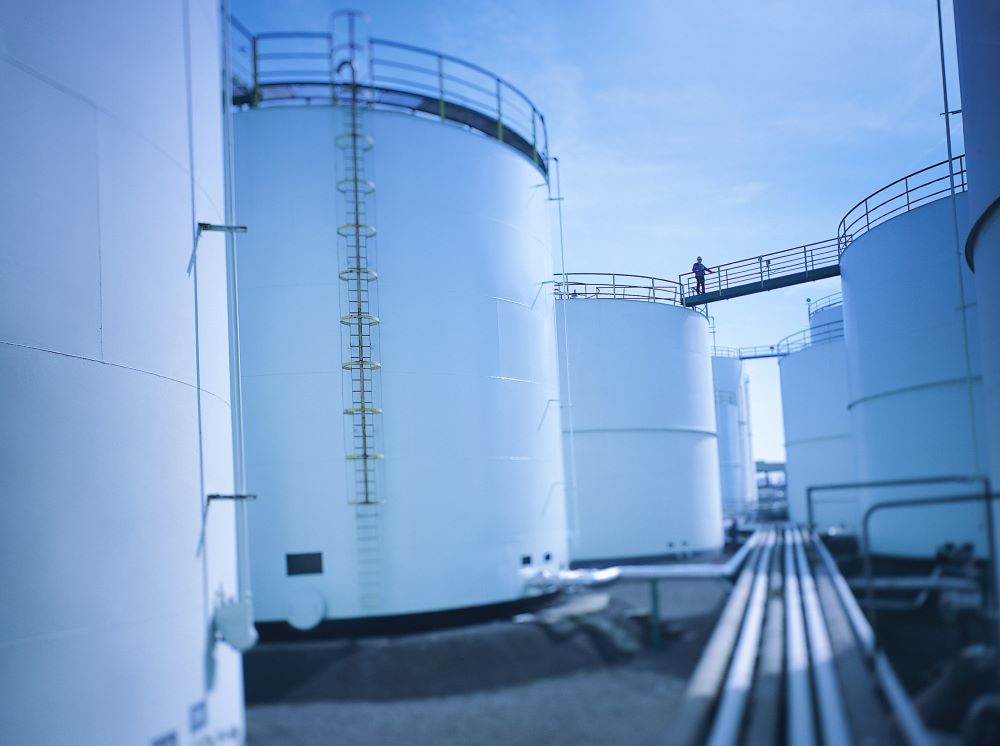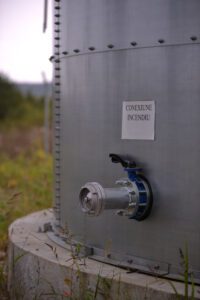As the owner of an industrial facility, you understand the importance of proper safety procedures and risk management. One area that requires close attention is the storage of flammable or combustible liquids. Fire protection tanks provide secure containment, but the insulation surrounding them serves as the first line of defense against the threat of fire. Choosing an above-ground storage tank insulation that can withstand high temperatures and resist ignition is critical to protecting your facility, employees, community, and the environment. When a fire breaks out, the right insulation buys you time to respond and helps limit the damage. It may seem like a small detail, but the performance and durability of your tank insulation directly impact safety and productivity. Investing in the best solution for your needs is well worth the peace of mind.
Why Insulate Your Aboveground Storage Tanks for Fire Protection?
Aboveground storage tank insulation is critical for fire safety and prevention. Properly installed tank insulation helps prevent the tank contents from overheating and igniting in the event of a fire. It also helps maintain the temperature of the tank contents for processing and quality control.
Reasons to insulate your Aboveground storage tanks:
- Prevents fire damage. Tank insulation acts as a protective barrier between the tank and external heat sources like fires. It helps prevent the tank from rupturing or exploding due to overpressure, which can lead to the uncontrolled release of flammable liquids and vapors.
- Maintain temperature. Insulation helps maintain the temperature of tank contents for quality control and processing. Temperature changes can affect the chemical and physical properties of many tank contents. Insulation minimizes heat transfer to and from the tank to keep temperatures steady.
- Safety compliance. Many local regulations and fire codes require insulation for aboveground storage tanks containing flammable or combustible liquids like gasoline, diesel, and chemicals. Properly installed insulation helps ensure your tanks meet all applicable safety standards.
- Cost savings. Insulation reduces heat transfer to and from the tank which lowers energy usage for temperature control. Less energy is required to maintain the temperature of tank contents which can significantly lower operating costs, especially for temperature-controlled tanks.
- Environmental protection. Insulation contains any hazardous vapors within the tank in the event of a leak or spill. It also helps prevent the overheating of tank contents which can lead to the release of volatile organic compounds into the atmosphere. Proper insulation is an important part of responsible environmental stewardship for industrial operations.
In summary, tank insulation should be an essential part of your fire prevention plan. It helps ensure the safety of personnel, protects the environment, and saves money by reducing operating costs and preventing damage or loss of tank contents. For the well-being of your operation, do not overlook the importance of insulation for your aboveground storage tanks.
Types of Insulation for Tanks :
When choosing insulation for tanks containing flammable or combustible liquids, selecting the proper type is critical for fire safety. There are three main options:
Mineral Wool
Mineral wool, such as rock wool or slag wool, is a popular choice for tank insulation. It is non-combustible and can withstand high temperatures. Mineral wool comes in blankets, boards, and pipe insulation. It is durable yet flexible and resists moisture. However, it can be irritating to work with and requires protective equipment. Mineral wool typically provides the best fire protection.
Foam
Foam insulation like polyurethane or polystyrene is also commonly used for tanks. It effectively insulates and is inexpensive, but most types are highly flammable. Special fire-resistant foams treated with flame retardants are available for high-risk areas. Foam requires an additional protective covering like a metal jacket for fire safety. It can melt, drip, and spread fire if ignited.
Fiberglass
Fiberglass insulation is another option for tanks. It is fire-resistant but not fireproof. Fiberglass comes in blankets, boards, and pipe covers. It insulates well for its thickness and cost but still requires an additional flame-resistant barrier. Fiberglass fibers can also irritate the skin, eyes, and respiratory system, so protective gear is needed during handling and installation.
In summary, for the best fire protection, mineral wool is the optimal choice for tank insulation whenever possible. Foam and fiberglass can work with proper safeguards and flame-resistant treatments, but may pose additional risks in the event of a fire. The type of insulation selected depends on the specific requirements and risks for each tank installation.
How to Choose the Right Insulation
When selecting insulation for your fire protection tank, choosing the right type and thickness is critical. The insulation acts as a barrier between the temperature-controlled environment inside the tank and the external environment.
Insulation Types
The two most common types of insulation for fire protection tanks are:
- Mineral wool: Made from spun fibers of rock or slag, mineral wool offers excellent fire resistance and thermal insulation. It can withstand temperatures up to 1,200°F. Mineral wool comes in blankets, boards, and pipe covers.
- Fiberglass Insulation and fire resistance: Composed of extremely fine glass fibers, fiberglass also provides good fire resistance and insulation. Fiberglass can withstand temperatures up to 900°F and comes in similar forms as mineral wool.
For high-heat applications like fire protection tanks, mineral wool is often preferable due to its higher maximum service temperature. Both mineral wool and fiberglass are non-combustible, moisture-resistant, and chemically inert. They pose no risk of corrosion to the tank.
Tank Insulation Thickness Requirements
The required thickness of insulation depends on several factors:
- The temperature difference between the internal and external environments. A greater temperature difference necessitates thicker insulation.
- The surface area of the tank. Tanks with a larger surface area need increased insulation to adequately control heat transfer.
- The material of the tank. The insulation thickness may need to be increased for tanks made of materials with higher thermal conductivity like carbon steel.
- Environmental conditions. Insulation exposed to harsh weather may require additional thickness for protection and to minimize heat loss.
- Energy efficiency needs. Thicker insulation helps improve the energy efficiency of the tank by reducing heat transfer and energy usage.
For most fire protection tanks, 3 to 6 inches of mineral wool or fiberglass insulation provides sufficient protection and energy efficiency. However, the specific requirements for your tank should be determined by a qualified professional. Proper insulation is essential to optimizing the performance, safety, and longevity of your fire protection tank.
5 Steps for Storage tank Insulation installation
Proper installation of tank insulation is critical for effective fire protection. As the first line of defense, insulation works to prevent the spread of fire to and from your storage tanks. When installing insulation on your tanks, there are several key steps to follow:
Selecting Insulation Material
Choose an insulation material rated for your tank’s maximum operating temperature as well as fire resistance. Common options include fiberglass, mineral wool, calcium silicate, and perlite. Fiberglass and mineral wool can withstand high heat but may require weatherproofing. Calcium silicate and perlite are weather-resistant but more dense. Consider the tank’s location and contents when determining the best insulation for your needs.
Cleaning the Tank Surface
Thoroughly clean the tank to remove any residue, debris, or standing water. An unclean surface prevents insulation from properly adhering, reducing its effectiveness. Scrub the entire tank with a degreaser or solvent and rinse well with water. Allow all surfaces to dry completely before moving on to the next step.
Applying a Sealant (Optional)
For added protection, you may apply a sealant or vapor barrier to the tank before installing insulation. Epoxy or silicone sealants prevent moisture from reaching the insulation. Apply 2-3 coats of your selected sealant, allowing it to dry as directed between coats.
Measuring and Cutting the Insulation
Measure your tank to determine the amount of insulation needed. Add 6-12 inches to account for overlap. Cut the insulation to size for your tank. For rounded tanks, make relief cuts to properly contour the insulation to the shape.
Securing the Insulation
Place the cut sections of insulation around the tank. Secure in place using tape, wire, straps, or bands. Wrap all the way around the tank, overlapping ends by at least 6 inches. Ensure the insulation is snug but still allows for expansion.
Following these best practices for installing tank insulation helps guarantee maximum protection against fire for the long term. Perform regular inspections to check for damage or shifting and make repairs or replacements as needed. Proper insulation installation and maintenance is a key part of an effective fire safety plan.
Storage Tank Insulation Maintenance
As with any industrial equipment, proper maintenance of your tank insulation is critical to ensuring safety, efficiency, and longevity. Routine inspection and repairs help prevent damage and keep your tank insulation functioning as intended.
Inspecting Your Tank Insulation
Regularly inspecting your tank insulation, ideally once a month or at a minimum every 3-6 months, allows you to identify any damage or wear before it becomes a serious issue. Look for signs of tearing, puncturing, cracking, or sagging in the outer jacket or vapor barrier, as well as any exposed or frayed insulation underneath. Also check that all seams and seals, like those around manways or other tank openings, are securely fastened and show no signs of coming loose.
Any issues found during the inspection should be repaired or patched immediately to maintain insulation integrity. Use insulation, jacketing, and sealants that are compatible with and rated for your tank’s specific conditions. For minor punctures or tears, insulation can often be patched. Larger damage may require replacing insulation sections or entire panels. Be sure to test repairs to ensure proper adhesion and sealing before putting the tank back into service.
Routine Maintenance
Beyond inspecting for damage, general maintenance helps maximize your tank insulation’s effectiveness and lifespan. Remove any built-up dirt or debris from the outer jacket, as this can retain moisture against the insulation. Re-secure any loose seams, connections or patches. And for certain insulation types like fiberglass, it may be necessary to re-wrap or re-tie loosened areas.
Proper maintenance of your tank’s insulation, along with the tank itself and any associated equipment, is essential for safety, compliance, and avoiding costly repairs down the road. Establishing a regular schedule of thorough inspections and minor maintenance can help keep your tanks running efficiently for years to come.
Conclusion
As a facility manager, your job carries immense responsibility to protect people and property. Ensuring your fire protection tanks are properly insulated is one of the most important steps you can take. While it may seem like a small detail, the right insulation acts as a critical first line of defense in an emergency situation. Don’t cut corners here or assume the insulation can wait until next month’s budget – make it a priority now. When it comes to managing risks, an ounce of prevention is worth a pound of cure. Invest in high-quality tank insulation and rest easier knowing you’ve strengthened your facility’s ability to respond in a crisis. The safety of everyone who enters your building is on the line.




